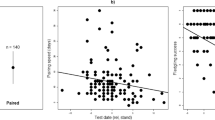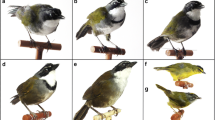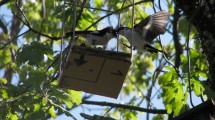Abstract
Individual behaviors of animals do not evolve separately; they do so in association with other behaviors caused by single shared genetic or physiological constraints and/or favored by selection. Thus, measuring behavioral syndromes—suites of correlated behaviors across different contexts—leads to a better understanding of the adaptive significance of variations in behaviors. However, relatively few studies have examined behavioral syndromes in wild animal populations in changing environments. We investigated a potential behavioral syndrome across antipredator nest defense, territorial defense, chick provisioning, and mating behaviors of male Black-tailed Gulls Larus crassirostris in two successive years under different conspecific territorial intrusion risks and food conditions. Males that presented high levels of antipredator nest defense (aggressive antipredator defenders) against a crow decoy (crows are egg predators) defended their territories against conspecific intruders more frequently than did other males (nonaggressive antipredator defenders), independent of the risk of intrusion. Aggressive antipredator defenders also fed their chicks more frequently than nonaggressive males, but only in a year of low food availability. Taken together, this indicates that males show consistent aggressiveness regardless of breeding context (antipredator and territorial defense), but can regulate food provisioning according to food availability.



Similar content being viewed by others
References
Bates D, Maechler M (2010) lme4: linear mixed-effects models using S4 classes. R package version 0.999375-37. http://CRAN.R-project.org/package=lme4
Bell AM (2005) Behavioural differences between individuals and two populations of stickleback (Gasterosteus aculeatus). J Evol Biol 18:464–473
Bell AM (2007) Future directions in behavioural syndromes research. Proc R Soc B-Biol Sci 274:755–761
Bell AM, Sih A (2007) Exposure to predation generates personality in threespined sticklebacks (Gasterosteus aculeatus). Ecol Lett 10:828–834
Clark MM, Galef BG (1999) A testosterone-mediated trade-off between parental and sexual effort in male mongolian gerbils (Meriones unguiculatus). J Comp Psychol 113:388–395
Dall SRX, Houston AI, McNamara JM (2004) The behavioural ecology of personality: consistent individual differences from an adaptive perspective. Ecol Lett 7:734–739
Day LB, McBroom JT, Schlinger BA (2006) Testosterone increases display behaviors but does not stimulate growth of adult plumage in male golden-collared manakins (Manacus vitellinus). Horm Behav 49:223–232
Dingemanse NJ, Kazem AJN, Reale D, Wright J (2010) Behavioural reaction norms: animal personality meets individual plasticity. Trends Ecol Evol 25:81–89
Duckworth RA (2006) Behavioral correlations across breeding contexts provide a mechanism for a cost of aggression. Behav Ecol 17:1011–1019
Gosling SD (2001) From mice to men: what can we learn about personality from animal research? Psychol Bull 127:45–86
Helfenstein F, Wagner RH, Danchin E, Rossi JM (2003) Functions of courtship feeding in Black-legged Kittiwakes: natural and sexual selection. Anim Behav 65:1027–1033
Hollander FA, Van Overveld T, Tokka I, Matthysen E (2008) Personality and nest defence in the great tit (Parus major). Ethology 114:405–412
Hunt GLJ, Hunt MW (1976) Gull chick survival: the significance of growth rates, timing of breeding and territory size. Ecology 57:62–75
Huntingford FA (1976) The relationship between anti-predator behavior and aggression among conspecifics in Three-spined Stickleback. Anim Behav 24:245–260
Kazama K (2010) Individual differences in aggressiveness and the function in the breeding colony in Black-tailed Gulls (Ph.D. thesis). Hokkaido-University, Hokkaido (in Japanese)
Kazama K, Watanuki Y (2010) Individual differences in nest defense in the colonial breeding Black-tailed Gulls. Behav Ecol Sociobiol 64:1239–1246
Kazama K, Sakamoto QK, Watanuki Y (2008a) Plasma testosterone levels of incubating Black-tailed Gulls. J Yamashina Inst Ornithol 39:112–116 (in Japanese with English abstract)
Kazama K, Tomita N, Ito M, Niizuma Y, Takagi M, Watanuki Y (2008b) Responses in breeding behaviour of Black-tailed Gull Larus crassirostris to different marine environments. In: Okada H, Mawatari SF, Suzuki N, Gautam P (eds) Proceedings of international symposium “The Origin and Evolution of Natural diversity,” 1–5 October 2007, Sapporo. Hokkaido University Press, Sapporo, pp 215–220
Kazama K, Niizuma Y, Watanuki Y (2010) Experimental study of the effect of clutch size on nest defense intensity in Black-tailed Gulls. Ornith Sci 9:93–100
Kazama K, Niizuma Y, Sakamoto QK, Watanuki Y (2011) Factors affecting individual variation in nest defense intensity in colonially breeding Black-tailed Gulls. Can J Zool 89:938–944
Kempenaers B, Lanctot RB, Gill VA, Hatch SA, Valcu M (2007) Do females trade copulations for food? An experimental study on kittiwakes (Rissa tridactyla). Behav Ecol 18:345–353
Ketterson ED, Nolan V Jr, Wolf L, Ziegenfus C (1992) Testosterone and avian life histories: effects of experimentally elevated testosterone on behavior and correlates of fitness in Dark-eyed Junco Junco hyemalis. Am Nat 140:980–999
Kosugi K, Sugimura N, Sato M (2005) Breeding colony status of Black-tailed Gull in Rishiri Island, northern Hokkaido. (1) Estimated population from 2002–2004. Rishiri Kenkyu 24:29–35 (in Japanese with English abstract)
Magrath MJL, Elgar MA (1997) Parental care declines with increased opportunity for extra-pair matings in fairy martins. Proc R Soc B 264:1731–1736
Magrath MJL, Komdeur J (2003) Is male care compromised by additional mating opportunity? Trends Ecol Evol 18:424–430
Nakagawa S, Schielzeth H (2010) Repeatability for Gaussian and non-Gaussian data: a practical guide for biologists. Biol Rev 85:935–956
Narita K, Narita A (2004) Observation reports of Black-tailed Gull. Kimura-Syoten, Hachinohe (in Japanese)
Pampoulie C, Lindstrom K, St Mary CM (2004) Have your cake and eat it too: male sand gobies show more parental care in the presence of female partners. Behav Ecol 15:199–204
Price T, Langen T (1992) Evolution of correlated characters. Trends Ecol Evol 7:307–310
Pugesek BH (1983) The relationship between parental age and reproductive effort in the California Gull Larus californicus. Behav Ecol Sociobiol 13:161–171
Pugesek BH (1990) Parental effort in the California Gull—tests of parent–offspring conflict theory. Behav Ecol Sociobiol 27:211–215
R Developmental Core Team (2010) R: a language and environment for statistical computing. R Foundation for Statistical Computing, Vienna. http://www.R-project.org. ISBN3-900051-07-0
Rands SA, Cowlishaw G, Richard A, Pettifor RA, Marcus J, Rowcliffe JM, Johnstone RA (2003) Spontaneous emergence of leaders and followers in foraging pairs. Nature 423:432–434
Réale D, Reader SM, Sol D, McDougall PT, Dingemanse NJ (2007) Integrating animal temperament within ecology and evolution. Biol Rev 82:291–318
Riechert SE, Hedrick AV (1993) A test for correlations among fitness-linked behavioral traits in the Spider Agelenopsis aperta. Anim Behav 46:669–675
Schwagmeyer PL, Mock DW (2003) How consistently are good parents good parents? Repeatability of parental care in the House Sparrow Passer domesticus. Ethol 109:303–313
Sih A, Bell AM (2008) Insights for behavioral ecology from behavioral syndromes. In: Jane Brockmann H, Roper TJ, Naguib M (eds) Advances in the study of behavior, vol 38. Elsevier, San Diego, pp 227–281
Sih A, Kats LB, Maurer EF (2003) Behavioural correlations across situations and the evolution of antipredator behaviour in a sunfish–salamander system. Anim Behav 65:29–44
Sih A, Bell AM, Johnson JC, Ziemba RE (2004) Behavioral syndromes: an integrative overview. Q Rev Biol 79:241–277
Sinn DL, Moltschaniwskyj NA, Wapstra E, Dall SRX (2010) Are behavioral syndromes invariant? Spatiotemporal variation in shy/bold behavior in squid. Behav Ecol Sociobiol 64:693–702
Stoehr AM, Hill GE (2000) Testosterone and the allocation of reproductive effort in male House Finches Carpodacus mexicanus. Behav Ecol Sociobiol 48:407–411
Takahashi A, Kuroki M, Niizuma Y, Kato A, Saitoh S, Watanuki Y (2001) Importance of the Japanese anchovy (Engraulis japonicus) to breeding rhinoceros auklets (Cerorhinca monocerata) on Teuri Island, Sea of Japan. Mar Biol 139:361–371
van Oers K, Drent PJ, Dingemanse NJ, Kempenaers B (2008) Personality is associated with extrapair paternity in great tits, Parus major. Anim Behav 76:555–563
Verbeek MEM, Drent PJ, Wiepkema PR (1994) Consistent individual differences in early exploratory behavior of male Great tits. Anim Behav 48:1113–1121
Watanuki Y (1987) Inter- and intra-specific differences in feeding habit in Laridae (PhD thesis). Hokkaido University, Hokkaido (in Japanese)
Watanuki Y (1992) Individual difference, parental care and reproductive success in Slaty-backed gulls. Condor 94:159–171
While GM, Isaksson C, McEvoy J, Sinn DL, Komdeur J, Wapstra E, Groothuis TGG (2010) Repeatable intra-individual variation in plasma testosterone concentration and its sex-specific link to aggression in a social lizard. Horm Behav 58:208–213
Wilson DS (1998) Adaptive individual differences within single populations. Philos T Roy Soc B 353:199–205
Wilson ADM, Whattam EM, Bennett R, Visanuvimol L, Lauzon C, Bertram SM (2010) Behavioral correlations across activity, mating, exploration, aggression, and antipredator contexts in the European house cricket, Acheta domesticus. Behav Ecol Sociobiol 64:703–715
Wolf M, van Doorn GS, Leimar O, Weissing FJ (2007) Life-history trade-offs favour the evolution of animal personalities. Nature 447:581–584
Acknowledgments
We thank Yasunori Sakurai for helpful comments during the course of the study. Thanks are also due to Kazuki Kosugi, Masahiko Sato, Rie Sato, Nobuaki Takahashi, Junko Kaji, Takazo Kawabata, Toru Nishijima, Kanako Nishijima, Shinya Okada, Hideo Takahara, Takayuki Fukuda, Takashi Hirotsu, Kanako Toge, Akito Mitumori, and Fumi Hirose for their support and assistance in the field. We are grateful to two anonymous referees for their very helpful comments and suggestions for improving the manuscript. We would also like to thank Thomas Van Pelt, and Mark Brazil, Scientific Editing Services, for correcting the English used in the manuscript. The Hokkaido Souya subprefectural office gave us permission (#36-1-5 in 2007 and #1-1-5 in 2008) to investigate the Black-tailed Gulls in the study areas on Rishiri Island. Parts of this study were conducted with the support of the Meijo University AGRIOMICS project.
Author information
Authors and Affiliations
Corresponding author
About this article
Cite this article
Kazama, K., Niizuma, Y. & Watanuki, Y. Consistent individual variations in aggressiveness and a behavioral syndrome across breeding contexts in different environments in the Black-tailed Gull. J Ethol 30, 279–288 (2012). https://doi.org/10.1007/s10164-011-0324-7
Received:
Accepted:
Published:
Issue Date:
DOI: https://doi.org/10.1007/s10164-011-0324-7




